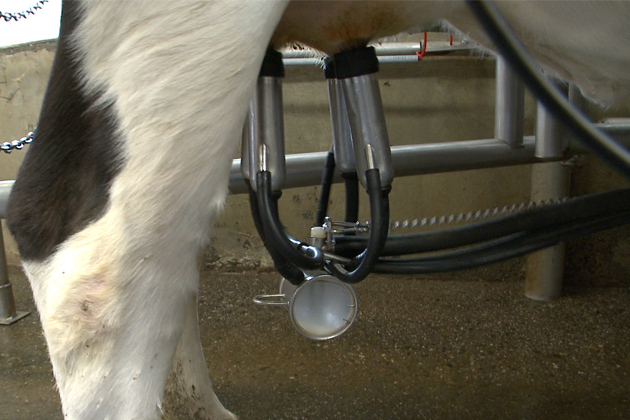[yframe url=’http://www.youtube.com/watch?v=cfSm9vgj6fY’]
Next time you savor a scoop of Dairy Bar ice cream, spare a thought for UConn’s award-winning dairy herd. The iconic black-and-white Holsteins that make up approximately 80 percent of the herd and their Jersey sisters have more than a little to do with why UConn Dairy Bar products taste so delicious.
But the herd’s value to the University extends far beyond providing the main ingredient in a double dip cone or sundae.

As a land grant university, UConn’s mission includes teaching, research, and outreach. The College of Agriculture and Natural Resources’ dairy herd embraces all three aspects of the mission in a symbiotic relationship that simultaneously serves students, the scientific community, and citizens of the state.
Under the direction of Mary Margaret Cole ’89 (CANR), executive program director in the Department of Animal Science, approximately 12,500 pounds of milk, or nearly 1,500 gallons, is shipped from Storrs to a central milk processing plant every other day throughout the year. This comes from a herd of approximately 100 Holstein and Jersey cattle, about three quarters of which are being milked on any given day. The remaining cows are those that are within a month or two of giving birth to the next generation of milk producers here at UConn.
Economic impact
The University’s milk production makes it an important contributor to the region’s dairy industry, which is responsible for more than $4 billion in output and nearly 32,000 jobs throughout the northeast. In a study called The Overlooked Economic Engine – Northeast Agriculture, released in 2012 by Farm Credit East, dairy production in the state ranked second only to the greenhouse and nursery industry in terms of production value and jobs created in the agriculture sector.
“We take our role in Connecticut agriculture seriously,” says Cole, “and we are meticulous about the health of our herd. Every student who comes through here, whether they are taking courses in dairy management, or doing pre-vet studies, or actually milking cows as work-study students, gains a thorough knowledge of our dairy operation and they know why our standards are so exacting.”

Indicative of the importance of herd management is the work being done by Sheila Andrews, professor of animal science and a Department of Extension dairy specialist. Andrews is an expert on mastitis, an infection of the mammary glands (or udder) that is the number one disease affecting dairy cows.
Nationwide, losses to the dairy industry amounting to upwards of $2 billion annually are attributed to this disease. Andrews is currently investigating the use of ultrasound technology for detecting mastitis, a technology that could lead to earlier treatment of infected cattle and help prevent its spread within a herd.
Bonnie Burr, assistant director and department head in the Department of Extension, cites Andrews’ work when she says, “Connecticut’s dairy industry has long relied on the work done at UConn with herd health and milk quality. The economic impact of this work has made our dairy industry one of the most progressive in the country.”
A living laboratory
Steve Zinn, head of the Department of Animal Science, adds that UConn’s herd affords students a living laboratory as they prepare for careers in veterinary medicine, animal behavior, pathobiology, dairy farming, pharmaceuticals, and other positions within the agriculture industry.
“Our animal science major is biology-based,” he says, “and I’m constantly getting feedback from students who go on to schools of veterinary medicine or other graduate work saying that they feel incredibly well-prepared. I think that’s because we focus not only on the breadth but the depth of our requirements within the major.”
Zinn adds that the presence of the dairy herd, as well as the other farm animals at UConn, is a significant bonus in attracting students and faculty. “Having the animals within walking or biking distance, having Mary Margaret’s expertise available in the classroom, allowing large-animal research projects to proceed in close proximity to state-of-the-art laboratory facilities – everything about our situation is really positive. In fact that’s why our animal science major has a bigger enrollment than at many other schools, including those in states with an even larger agriculture-based economy.”
Cream of the crop
UConn’s commitment to excellence has paid off, and the quality of the herd is recognized nationally by those within the dairy industry. In 2013 alone, the dairy won the Agri-Mark Top Milk Quality Award in the Northeast Region, as well as the Progressive Breeders Registry Award that honors the highest standards of both production and type in registered Holsteins. The milk is used to make the quality ice cream and artisanal cheese sold at the Dairy Bar, and is responsible for making UConn a perennial favorite throughout the region for those in search of high caliber dairy products.
This past weekend, Cole traveled to Fort Worth, Texas to accept a Gold Award from the National Mastitis Council on behalf of the University. The award signifies that the UConn herd has been named one of the top 50 dairy herds nationwide, out of some 51,000 recognized herds. Among the criteria for this award are the quality of the milk produced, the overall health of the cows, in-place health monitoring programs, and adherence to drug use and record-keeping regulations.
The honor was presented before dairy industry professionals from around the world who gathered to exchange information on udder health, milking management, and milk quality.
Says Cole, “Our success is really pretty simple. We have great students and a great staff, we do great research, and,” she adds with a smile, “we have a great bunch of cows.”



